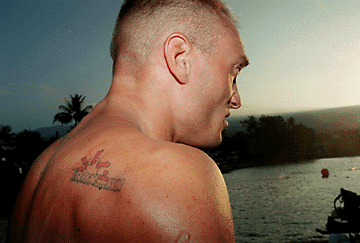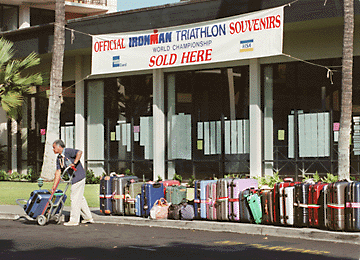

Friday, October 2, 1998
Of muscle...
and money
The triathlon brings
By Rod Thompson
thousands of people—
and millions of dollars
—to Hawaii
Star-BulletinKAILUA-KONA -- Christmas comes early every year to the merchants of Kailua-Kona -- the gift of 1,500 of the top athletes in the world.
The 20th Anniversary Ironman Triathlon World Championship will be swum, biked and run tomorrow, bringing with it sleek bodies, good feelings and lots of money.
"This is Christmas plus," said race finish line director and bicycle shop owner Gerry Rott. "Ironman is roughly one third of our annual sales volume."

Rott's B&L Bike and Sports shop normally has half a dozen people in it at any given moment, she said. During the Ironman season, 60 to 100 people are there at a time.A study by the state Department of Business, Economic Development and Tourism estimated that Ironman will generate $14.9 million in direct sales this year.
With the multiplier effect of the money being respent, total sales generated will be $26.2 million, the state said.
Rocky Campbell, Ironman's volunteer director of construction and owner of Trojan Lumber Co. in Kailua-Kona, said athletes and their friends spend money in local businesses, which keep local people employed.
"Their workers can fix up their homes and that helps me," he said.
This is against an economic backdrop in Kona throughout the 1990s, where small businesses have struggled. "A lot of guys have gone belly up," Campbell said.
Some of the bigger businesses depend on Ironman, too. Casey Ballao, marketing manager for King Kamehameha's Kona Beach Hotel, where the race is headquartered, says the hotel is always sold out during the race.
At other times, occupancy is 55 percent to 60 percent.

Lyn Brooks of Boston has participated in every Ironman since it moved to the Big Island in 1981, including twice in 1982 when it was run in February and October. She estimates she's spent $60,000 on the event over the years. "You don't just move in and out without spending money," she said.Richard Hoyt, who towed, pushed, and bicycled his cerebral palsy-striken son Rick, now 36, through the 1989 event, brought 11 people with him this time, even though he's not competing.
The state study found that roughly half of Ironman athletes have incomes over $75,000 a year. They spend an average of $1,187 on lodging alone. And about a quarter of them visit other islands.
Winnie Gillette from Orange County, Calif., got into the race by winning other races, but she notes that others who get in via a lottery may make more of an economic contribution.

"The lottery is the chance of a lifetime. It's a first-time event and probably a last-time event," she said. Those are the people who are going to bring family members with them to watch, she said.Candace Duthie of Colorado Springs, traveling with her mother and father, came to watch her daughter, Teri, compete. Duthie's father, Terry Hutchinson, was just starting to consider buying real estate. "I'm very impressed with the island," he said.
"It's just kind of hometownish. No high-rises," said Duthie.
Kona's largely undeveloped nature was what brought the Ironman here in 1981.
The event began as a challenge by runner and swimmer John Collins with 15 people competing on Oahu in 1978.
By the end of the 1980 event, race director Valerie Silk, now living in Florida, recalls it was already too big to fit on Oahu.
She and Kona Surf Hotel manager Robert Herkes, now a state legislator, agreed to move the event to Kona in 1981 and be based at his hotel.

"Heck, we need the business," Herkes thought. "They won't be around next year."But the Ironman did come back, and witnessed one of the most dramatic moments in the event. College student Julie Moss, the leading woman, dehydrated and staggering, collapsed 20 yards short of the finish line, yet crawled to the finish.
Dr. Bob Laird, medical director of the race since 1981, now oversees a team of 290 volunteer doctors and nurses, spending their own money to assist with the race.
About a third of the entrants need some form of medical attention during the event, he said.
The amount of supplies to put on the event fills a Kona warehouse 12 feet high, said warehouse supervisor Leilani Mattson.
One of 7,000 volunteers, Mattson actually loses money on the race, since she takes two weeks off from her job to help put it on.
She does it, "because it gives back to the community. It's the aloha spirit. You go down to the pier (where the race begins and ends) and you have people hugging, crying, emotional, spiritual," she says.
Among the things she's in charge of: 150,000 pounds of ice, 30,000 sponges, 25,000 water bottles, and 1,200 trash cans.
One sign of the community acceptance of the event: Mattson's crews put out the supplies at unattended aid stations along Queen Kaahumanu Highway days in advance. No one touches them.
The Ironman facts
The economic impact
A study by Hawaii's Department of Business, Economic Development and Tourism estimates that the Ironman will generate $14.9 million in direct sales this year, with total sales reaching $26.2 million.
The averages
Average training distances for each event:
7 miles per week swimming
232 miles per week biking
48 miles per week running
Average finishing time in 1997:
11 hours, 47 minutes, 30 seconds
Average hours devoted to training each week:
18-22 hours
1,479 athletes competed in 1997, 114 did not finish
The course
Run:
Course length: 26.2 miles
Maximum time allowed: 17 hours
Fastest times: Mark Allen, 2 hours, 40 minutes, 4 seconds (1989); Erin Baker, 3 hours, 4 minutes, 13 seconds (1990)
Bike:
Course length: 112 miles
Maximum time allowed: 10 hours, 30 minutes
Fastest times: Thomas Hellriegel, 4 hours, 24 minutes, 50 seconds (1996); Paula Newby- Fraser, 4 hours, 48 minutes, 30 seconds (1993)
Swim:
Course length: 2.4 miles
Maximum time allowed: 2 hours, 20 minutes
Fastest times: Lars Jorgensen, 46 minutes, 44 seconds (1995); Wendy Ingraham, 49 minutes, 52 seconds (1997)
How to qualify
Athletes gain entry into the Ironman Triathlon World Championship in one of two ways:
Earning a qualifying spot at one of the 14 U.S. domestic qualifying events, or one of the seven international qualifying races held throughout the year.
A lottery which awards 150 spots into the championship.
Source: 1998 Ironman Media Information Guide
Ironman setting
By Pat Bigold
for more drama
Star-BulletinWendy Ingraham and Sian Welch gave the 1997 Ironman World Championships the kind of drama no triathlon could buy.
Within 50 yards of the finish line in Kailua-Kona, the two women simultaneously suffered severe cramps and wound up racing each other to the finish on their hands and knees before a worldwide TV audience.
"It was like someone took a baseball bat and whacked my legs," said 34-year-old Wendy Ingraham of Walnut Creek, Calif., who finished fourth among the women.
"It was an experience that made me better," said Welch, "but I put it out of my mind a long time ago."
Both women are back on the Big Island for tomorrow's Ironman, and neither wants a repeat of the bizarre incident dubbed, "The Diaper Dash."
"I plan to use a little more nutrition this year," said Welch, who was fifth.
The 31-year-old San Diego resident found herself vomiting during the 112-mile bike ride.
"I had no electrolytes and was only drinking Coke and water."
Ingraham said her salt tablets fell out of her wrist band on the run, and that created problems for her last year.
"I need a lot of sodium in my body," she said. To make sure she doesn't lose all of her tablets, she said she will tuck them various pieces of clothing on her person.
Ingraham was leading the women's race until the 15th mile when the loss of her sodium tablets caused the cramps to begin.
Welch arrived in the finish area in third place but wound up fifth after struggling to the finish on the strength of spectator chants of "Crawl! Crawl!"
Her husband, Greg Welch, dragged her off the course after she got across the line.
"Mentally, it made me stronger and now I can probably get through anything," said Ingraham who was picked up by her boyfriend and carried away.
The top three finishers of 1997, all Germans, are back.
They are led by defending champion Thomas Hellriegel, who won in 8 hours, 33 minutes and one second.
Jurgen Zack followed him in 8:39:18 and Lother Leder was third in 8:40:30.
But Belgium's Luc Van Lierde, the 1996 winner at Kona, is seen as the favorite this time.
Defending women's champion Heather Fuhr returns. She captured the course in a come-from-behind effort in the run in 9:31:43.
She will be joined in the race by Welch, Ingraham and eight-time winner Paula Newby-Fraser.
Julia Wallace will become the first wheelchair competitor in the event's 20-year history.
The facts
What Ironman World Championships
Where Kailua-Kona
When Tomorrow
Distances 2.4-mile swim; 112-mile bike race; 26.2-mile run.